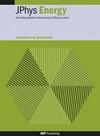Entropy change reversibility in MnNi1-xCoxGe0.97Al0.03 near the triple point
IF 6.3
3区 材料科学
Q1 ENERGY & FUELS
引用次数: 0
Abstract
Abstract The nature of the phase transition has been studied in MnNi 1− x Co x Ge 0.97 Al 0.03 ( x = 0.20–0.50) through magnetization, differential scanning calorimetry and x-ray diffraction measurements; and the associated reversibility in the magnetocaloric effect has been examined. A small amount of Al substitution for Ge can lower the structural phase transition temperature, resulting in a coupled first-order magnetostructural transition (MST) from a ferromagnetic orthorhombic to a paramagnetic hexagonal phase in MnNi 1− x Co x Ge 0.97 Al 0.03 . Interestingly, a composition-dependent triple point (TP) has been detected in the studied system, where the first-order MST is split into an additional phase boundary at higher temperature with a second-order transition character. The critical-field-value of the field-induced MST decreases with increasing Co concentration and disappears at the TP ( x = 0.37) resembling most field-sensitive MST among the studied compositions. An increase of the hexagonal lattice parameter a hex near the TP indicates a lattice softening associated with an enhancement of the vibrational amplitude in the Ni/Co site. The lattice softening leads to a larger field-induced structural entropy change (structural entropy change≫ magnetic entropy change, for this class of materials) with the application of a lower field, which results in a larger reversibility of the low-field entropy change (|Δ S rev | = 6.9 J kg −1 K for Δ μ 0 H = 2 T) at the TP.MnNi1-xCoxGe0.97Al0.03在三相点附近的熵变可逆性
通过磁化、差示扫描量热和x射线衍射测量,研究了MnNi 1−x Co x Ge 0.97 Al 0.03 (x = 0.20-0.50)的相变性质;并研究了磁热效应中相关的可逆性。少量Al取代Ge可以降低结构相变温度,导致MnNi 1−x Co x Ge 0.97 Al 0.03中由铁磁正交向顺磁六方相耦合的一阶磁结构转变(MST)。有趣的是,在所研究的体系中检测到组分依赖的三相点(TP),其中一阶MST在较高温度下分裂成具有二阶转变特征的附加相边界。场致MST的临界场值随Co浓度的增加而减小,在TP (x = 0.37)处消失,与所研究组分中大多数场敏感MST相似。在TP附近六边形晶格参数的增加表明晶格软化与Ni/Co位置的振动振幅增强有关。在低场作用下,晶格软化导致更大的场致结构熵变(结构熵变比磁熵变要大),从而导致TP处低场熵变的可逆性更大(Δ μ 0 H = 2 T时,S rev | = 6.9 J kg−1 K)。
本文章由计算机程序翻译,如有差异,请以英文原文为准。
求助全文
约1分钟内获得全文
求助全文
来源期刊

Journal of Physics-Energy
Multiple-
CiteScore
10.90
自引率
1.40%
发文量
58
期刊介绍:
The Journal of Physics-Energy is an interdisciplinary and fully open-access publication dedicated to setting the agenda for the identification and dissemination of the most exciting and significant advancements in all realms of energy-related research. Committed to the principles of open science, JPhys Energy is designed to maximize the exchange of knowledge between both established and emerging communities, thereby fostering a collaborative and inclusive environment for the advancement of energy research.
 求助内容:
求助内容: 应助结果提醒方式:
应助结果提醒方式:


